Since the end of the pandemic, we here at Fish’n Canada have been taking full advantage of our ability to see the country once again. As incredible as it has been to reunite with the mountains of BC, the rivers of New Brunswick, and the vast expanses of the Northwest Territories, we still do, every now and then, like to hang around close to home.
Although we may be taking a “rest” from our usual travel schedule, we’re not talking about settling for a local crappie hole or stocked trout pond. On this Fish’n Canada episode, our intent was to show you that the monsters so often associated with Northern BC and the Northwest Territories are accessible in Ontario as well, and just hours away from the Greater Toronto Area.
To do this, we headed to Loon Lodge on Lake Temagami to meet with owners Adam and Kayla Pugh. This lodge is legendary on Lake Temagami for not only its success rate in fishing, but believe it or not, its burgers! But, that isn’t (just) what we were there for. We were there for something else that Adam specializes in: “Sharpshooting” world-class Lake Trout.
The concept of “sharpshooting” is something that will be familiar to bass anglers, but is likely outside of some Lake Trout angler’s repertoire. The reason for this is that “sharpshooting” refers to targeting individual fish after spotting them on your sonar, something that is sometimes difficult due to the Lake Trout’s love for deep water and erratic movements. That was, however, until LiveScope came into the picture.
As many of you now know, LiveScope lets you see fish in true real-time, allowing anglers to react to the fish’s every movement rather than working seconds behind it. To add to this accuracy and to tilt things really in our favour, we’re going to be experimenting with a brand new setup designed to take the guesswork out of locating these often unpredictable fish.

Here are our two bow Garmin screens in LiveScope mode. The top unit shows us Forward View through our LiveScope Plus transducer. The bottom unit shows us Perspective View through our XR transducer. And for those skeptics, trust us, the fish still do have a chance!
With the boat fully decked out and the electronics ready for usage, the boys headed out to the first spot of the day, a deep shoal coming up from 100 feet into roughly 70. It did not take long before we saw fish cruising the bottom.
This is one thing that this technique has changed for us and is what gives sharpshooting its name. In the past, with traditional CHIRP sonar, many Lake Trout anglers waited to see balls of bait or schools of fish that would justify stopping the motor and deploying the gear, or they would concentrate on that area when trolling (i.e repetitive circles etc.). With LiveScope, however, these big, solitary fish are fully accessible, as their location can be seen in real-time and their movements and moods can be analyzed much more precisely. Thankfully, the mood of these fish was instantly recognizable as “Active”.
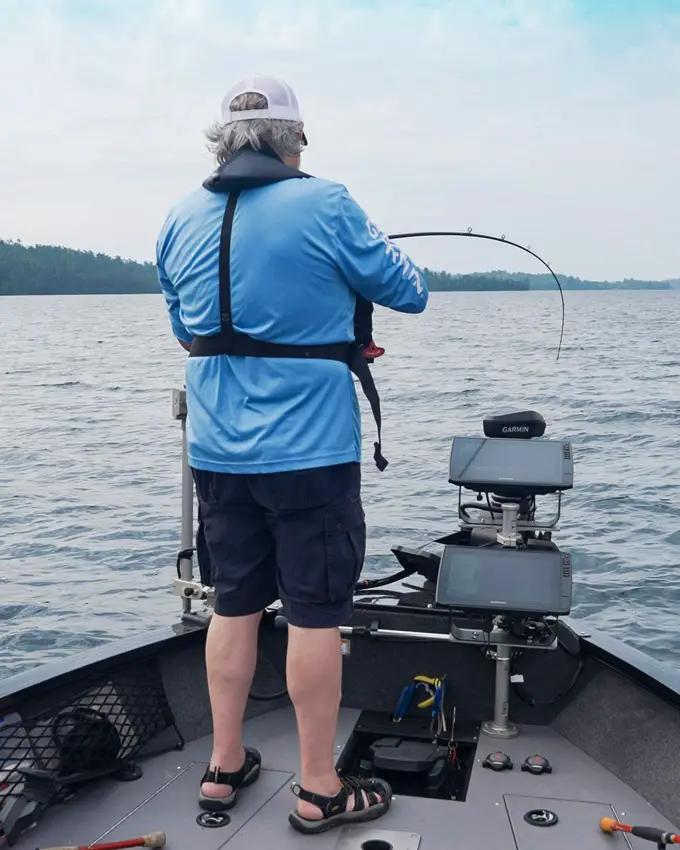
Doing battle with these Temagami Lakers will strain both equipment and angler. World-class Lake Trout accessible to all!
Ang tied into the first big Lake Trout on this trip. After a long and strenuous fight, when all was said and done and the fish was released, it was nearly 10 in the morning, a time that Adam warned us often proved to be the end of the morning Lake Trout bite, especially in the heat of summer.
We toughed it out in this spot a bit longer to test the theory, but Adam’s mid-morning thoughts seemed to be correct and the fish on the screen became wary of everything that dropped from above. It was time to re-group, record a podcast, and prepare for the next morning bite.
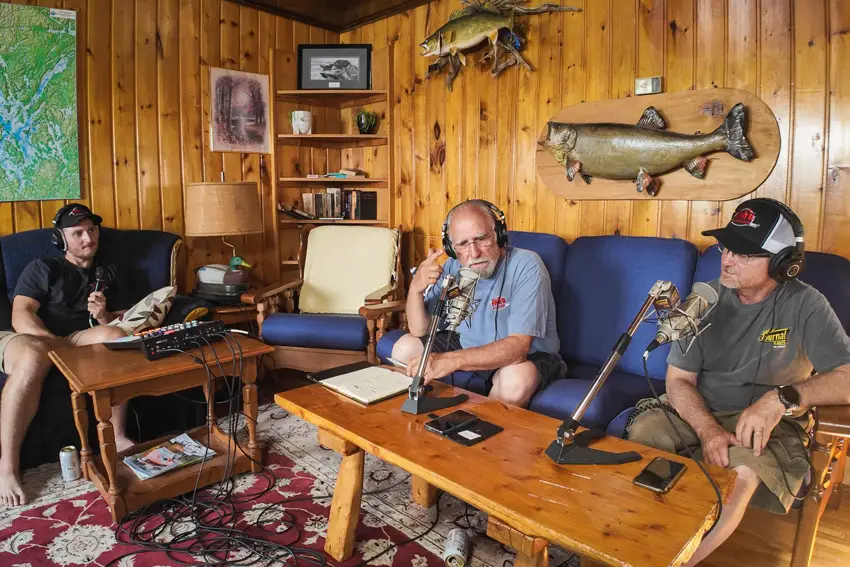
An Outdoor Journal Radio podcast is always a possibility when traveling abroad. In fact, we call them “On The Road Again”
The following morning we woke up before the sun, wiped the dew off the seats of our Princecraft, and glided along the glass-calm lake following behind our guide. Adam slowed down in front of us as our sonar began to climb from 120’ to 75’ and his voice crackled through our radio, “boys, this is where dreams often come true.” It took us about five minutes to figure out why.

On the first drop of the day, a blob on our LiveScope met Ang’s tube jig before it even hit bottom and his rod bent like he was hooked to an anchor. In fact, this is exactly what the fish fought like and we watched it on our sonar as it repeatedly darted straight to bottom, from 30 feet down to nearly 100 every time it caught a glimpse of the boat. Eventually, after chasing the fish for nearly 15 minutes, we got her in the net and got a few pictures that are undoubtedly bound for the Loon Lodge trophy wall.
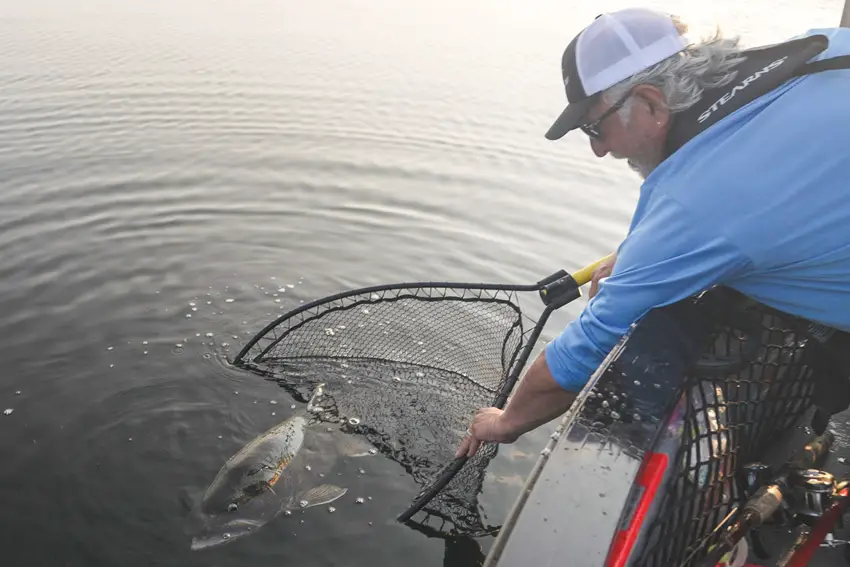
Ang releases his massive capture after a grueling fight
One thing that may be crossing your mind as you read through this article is the issue of barotrauma. After all, we have talked repeatedly on the Outdoor Journal Radio podcast about the increased mortality rates caused by fishing in deep water and the ethical concerns over doing it during the heat of summer when the fish are at their most vulnerable. Lake Trout, however, are a bit of an exception to the rule.
Unlike most fish, who rely solely on outside pressure to regulate the air in their swim bladder, Lake Trout have the ability to manually inflate and deflate their swim bladder when transitioning from drastic changes in water depth. They do this by literally burping out the air from their swim bladder and pressure changes, something that is even visible on LiveScope if you watch the fish as they swim to the surface!
That being said, this does not take the Laker barotrauma rate all the way to zero. There are a couple ways Lake Trout can experience barotrauma. One is if they are caught in extremely deep water (120+ feet). This seems to up the odds of BT. The other is if a Laker fights in an upward motion meaning they come to the surface too quickly. This is exactly what happened when Pete later hooked into another giant Lake Trout (no burping) who required some TLC and a unique piece of equipment to get her back down to depth and healthily swimming away.
If a Lake Trout gives a hard, prolonged fight all while staying deep, chances are barotrauma may be avoided through burping.
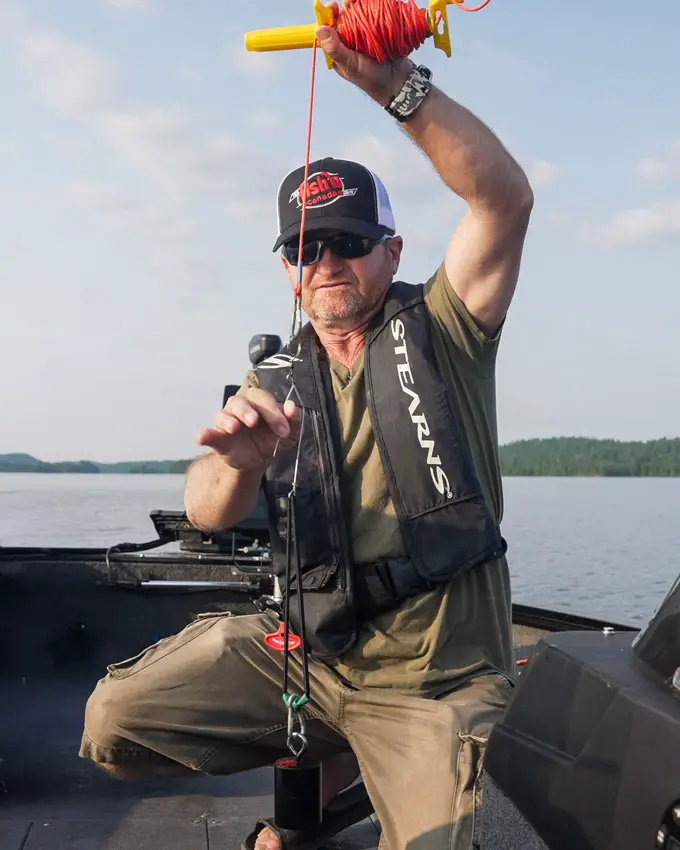
Pete’s homemade descending device
From the Minnesota DNR Site About Barotrauma
Fish differ in their susceptibility to barotrauma based on their physiology and behavior. One of the major determinants of a fish’s susceptibility to barotrauma relates to the morphology of their gas bladder. This organ allows fish to control their buoyancy by both inflating the organ using gases from the bloodstream as well as by contracting a layer of muscle surrounding the gas bladder. Physostomous fish like lake trout, muskellunge and sturgeon can expel gas from their air bladder into their digestive tract allowing them to “burp” gas and avoid some of the effects of barotrauma. Physoclistous fish such as black crappie, smallmouth bass and walleye lack the ability to expel gas through their air bladder and are more susceptible to some barotrauma effects. In physostomes, delicate organs responsible for adding or removing gases from the gas bladder (gas gland and ovale) can also be damaged and result in more severe buoyancy control impairment.
After Pete released this fish on the device, Ang actually watched the whole sequence on LiveScope and was literally blown away as to what unfolded on the screen. It was a perfect execution and the fish swam away on its own.
Ang and Pete continued sharpshooting and landed a total of 5 fish, all weighing over 20 pounds with three of them probably pushing 30, something they never thought possible south of the territories!
All in all, this shoot was so fun and fulfilling for the boys that they can’t wait for it to hit the TV and YouTube.
LAKE TEMAGAMI
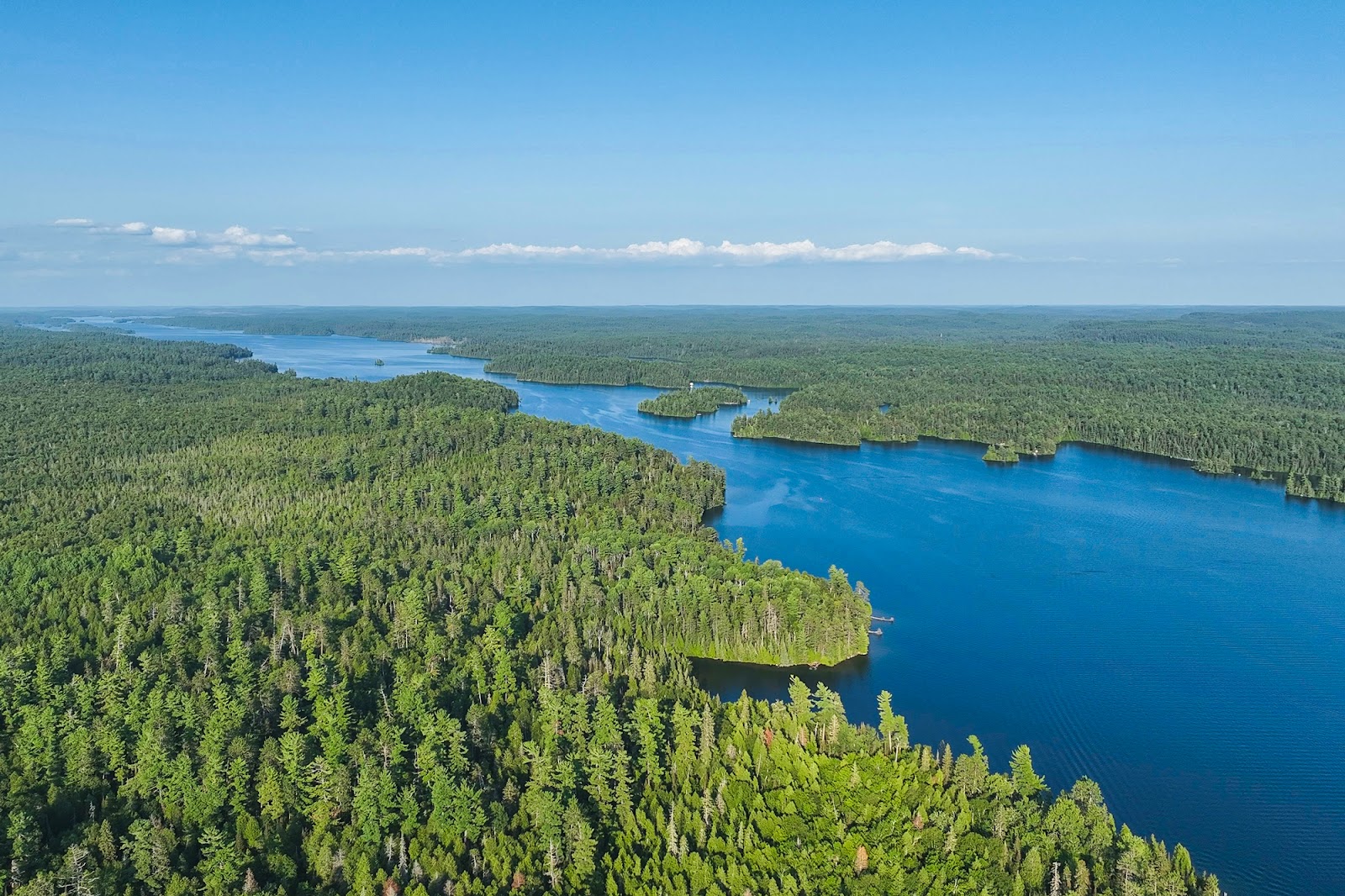
Lake Temagami, located in Nipissing District in northeastern Ontario, Canada, is approximately 80 km north of North Bay. The lake’s name originates from the Ojibwa term “dimii-agamiing,” meaning “it is deep water by the shore.”
Area: The lake covers an area of approximately 21,216.8 hectares (52,429 acres).
Depth: Lake Temagami has a maximum depth of 110 metres (363 feet) and a mean depth of 18.2 metres (60 feet).
Shoreline: Lake Temagami boasts a complex shoreline stretching about 1,030 kilometers (640 miles), featuring numerous branches, bays, and islands.
Islands: There are around 1,259 islands within the lake, with Temagami Island being one of the most notable.
Elevation: The lake sits at an elevation of approximately 293.62 meters above sea level.
Primary Inflow: The lake receives water mainly from the Anima Nipissing River.
Primary Outflow: Water exits the lake via the Temagami River.
Water Levels: The water levels of Lake Temagami are regulated by the Cross Lake Control Dam, constructed in 1917 and refurbished in 1999. As of December 12, 2024, the recorded water level was 293.62 meters, with an outflow of 17.2 cubic meters per second.
Recreational Activities: Lake Temagami is renowned for recreational activities such as fishing, canoeing, and camping. Anglers can find species like lake trout, walleye, smallmouth bass, and northern pike in its waters.
Navigation and Mapping: For boating and fishing enthusiasts, detailed nautical charts and depth maps are available, providing information on fishing spots, lake depth contours, and navigation aids.
LOON LODGE
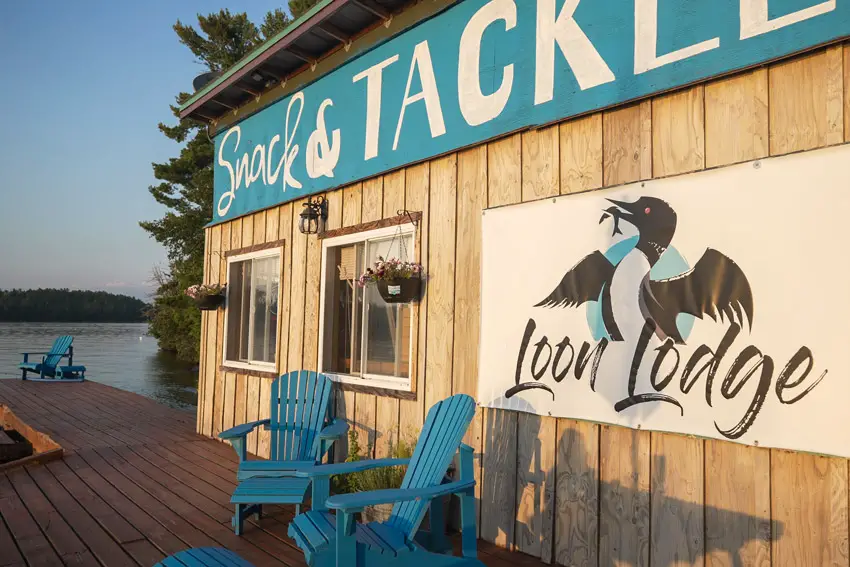
Loon Lodge has been running successfully for over 60 years on Lake Temagami. Newly taken over in late 2020, by Adam and Kayla Pugh, they are determined to provide guests with a fishing trip to remember whether you will be fishing from the boat or ice fishing from one of our heated, on ice, Ice Bungalows!
Spring/Summer/Fall Fishing
Come stay at Loon Lodge any time of year. Island accommodations are available year round. So whether you want to come for the Spring opener, beautiful Summer days, or some cool Fall fishing before the snow flies, Loon Lodge has a place for you.
Ice Bungalows
If you love to drop a line in the Winter, Loon Lodge has 6 Ice Bungalows that can accommodate 4 people. Lake Temagami offers amazing ice fishing opportunities for Lake Trout, Walleye, Whitefish, and Ling.
They take Ice Bungalow bookings year round! To ensure you get the dates you want, book 6 months to a year in advance!
LAKE TROUT ICE SEASON: February 15 – March 16 2025
The Lodge Offers:
Tackle – Leeches and Worms
Kitchen – take out or eat on picnic table overlooking lake
Misc Grocery items: milk, cream, eggs, drinks, butter, toilet paper, paper towel, salt, garbage bags, etc.
Novelty Ice Creams
Scoop Ice Creams and Milkshakes
Fish Crisp
Chips
Catherine’s Hot Pepper Jelly and Antipasto
ADAM’S OUTFITTING GUIDE SERVICE
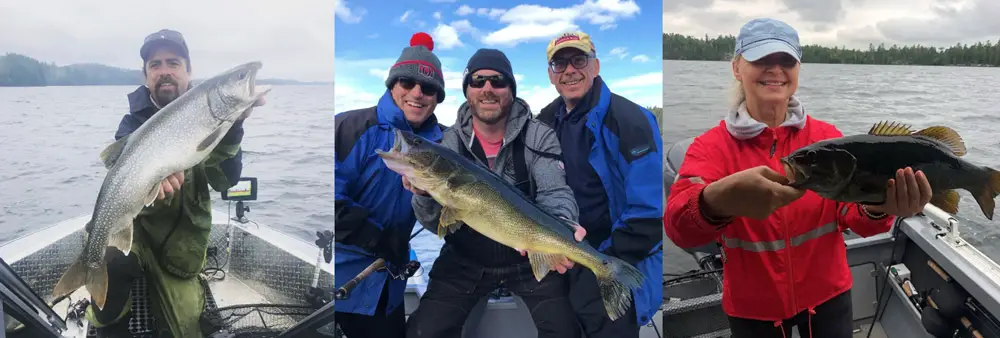
Lake Trout, Walleye, and Smallmouth Bass are Adam’s specialty however trust us, you need to charter him for open water Lakers just one day… It’s so awesome!
Loon Lodge is the home of Adam’s Outfitting. With over 15 years of experience as a fishing guide across Ontario Adam makes sure you’re in good hands tracking down your next fish of a lifetime!
Temagami is a massive lake so hiring Adam will speed up your chances at catching that memory you can hang on your wall!
Fish with Adam out of his beautiful 20 ft Kingfisher boat rigged with all the fish-catching bells and whistles. All you need is two feet and a heartbeat and let Adam take care of the rest! Maximum 3 people for a great day of catch and release fishing.
EPISODE HOTSPOT
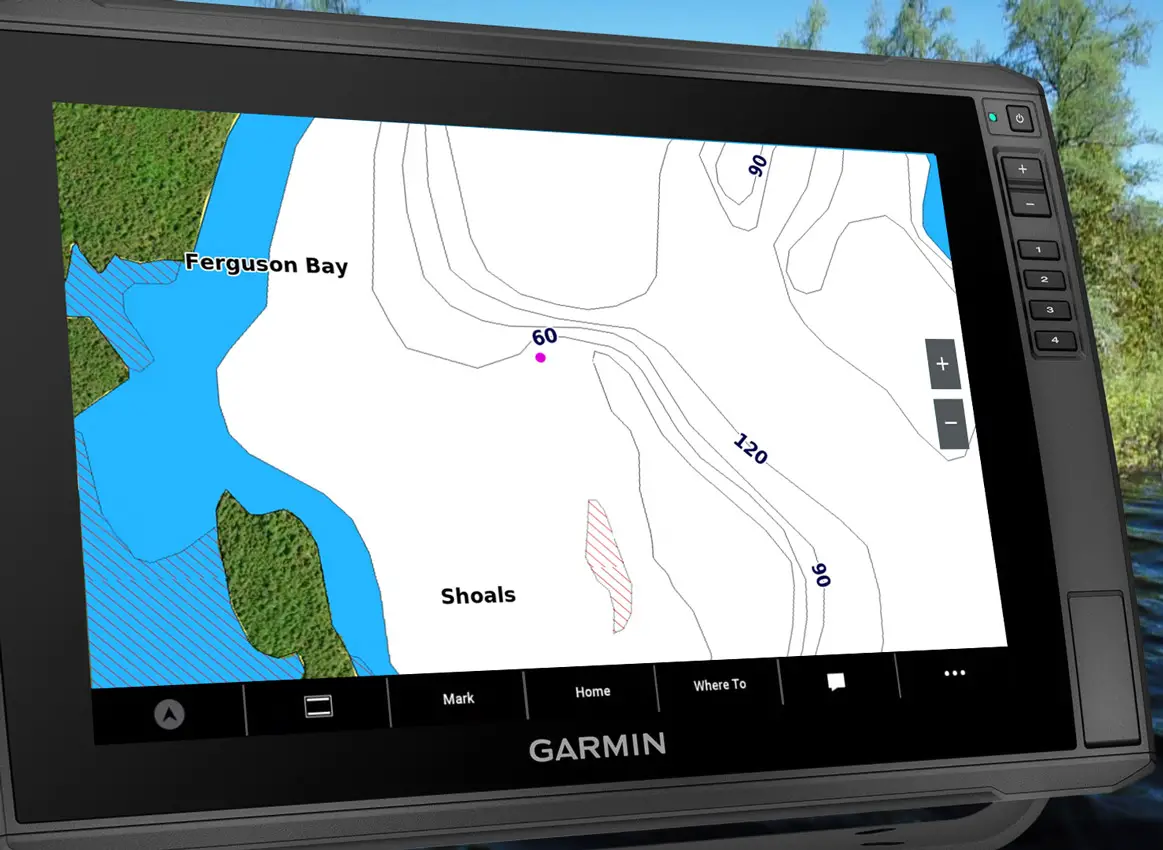
This Hotspot is an underwater hump on Lake Temagami that holds a multitude of fish species including, of course, Lake Trout.
The key to catching the residing Lakers here during the warmer summer months is to scour the deep drops on the outside edges of the shoal. We’d recommend at least 50 feet deep with 60 – 80 feet being the best for us.
Of course, if you have LiveScope on your boat, it will make things much easier in locating fish. Trust us, big lakers show up perfectly while scoping these depths. Catching them though… that’s another story. We’ll leave that up to you.
Please remember that big Lake Trout are a minimum of 25-30 years old and some fish on this lake will exceed 75 years of age… a true Canadian giant that deserves to be released back into the wild.
For the GPS coordinates to this HotSpot and so many more, go to our Fish’n Canada HotSpots Page
Depth: 60 – 80 Feet
Baits: Tubes, Jigs,
Presentation: Vertical Jigging, Dragging
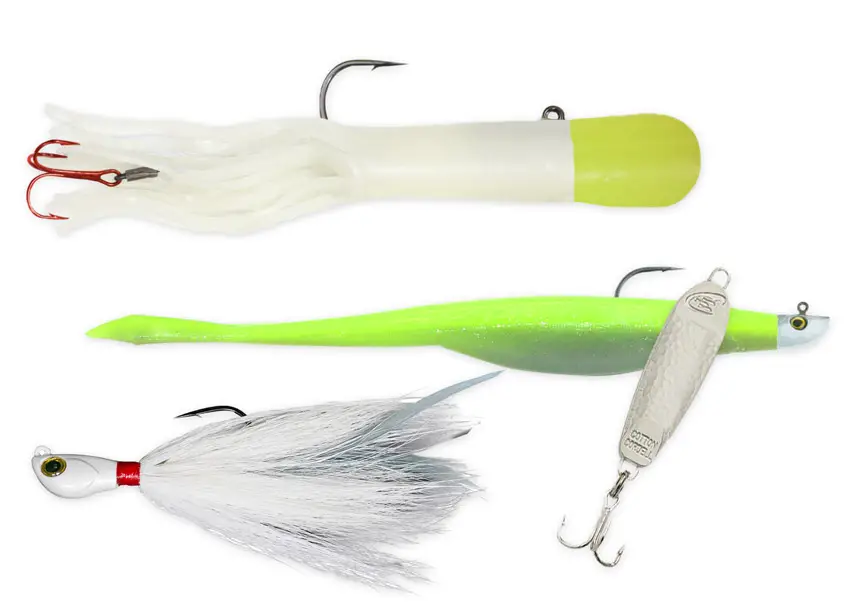
Jigs and more jigs are the deal on Temagami
GETTIN’ THERE: LOON LODGE
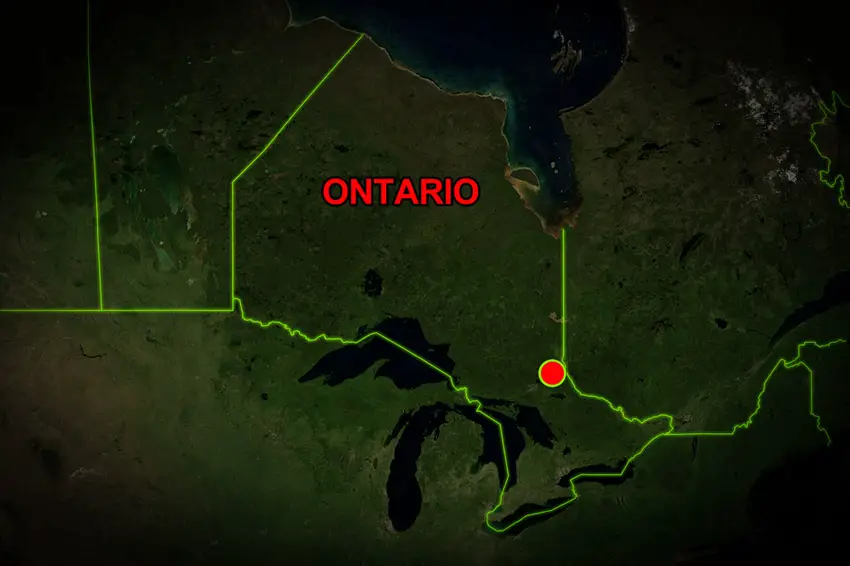
To get to this episode’s unbelievable Laker fishing on Lake Temagami, Ang & Pete first drove north on Hwy 400 until we reached the city of Barrie.
They then continued north on hwy 11.
They stayed on hwy 11 through North Bay until we reached the lake.
They finally turned west on Lake Temagami Access Road.
This is the main access point to Lake Temagami. Once you get to the end, you’ll see the car park and boat launch.
Once you launch your boat, Loon Lodge is right around the bend.
You can stay at the main lodge or rent a cozy private cabin.
Loon Lodge has a full meal plan available, but if you prefer to cook your own meals, each location comes with a full kitchen.
Loon Lodge is famous for its Loon Burgers, which are sold at their little snack & tackle shack. Trust us, all the food here is delicious and NO it’s not an actual loon burger, it’s just a catchy name!
And finally, if you’re a hard-water angler, Loon Lodge rents out fully equipped Ice bungalows for winter fishing.
A great place run by great people!
TEMAGAMI ONTARIO
Courtesy Northeastern Ontario
Temagami, located in Nipissing district of northeastern Ontario, Canada, is a small municipality that is renowned for its pristine natural landscapes, rich cultural heritage, and abundant outdoor recreational opportunities. At the heart of this region lies Lake Temagami, a vast body of water celebrated for its deep, clear waters and over 1,200 islands. The name “Temagami” itself is derived from the Ojibway word “te maw ga mee,” meaning “deep water by the shore.”
Natural Beauty and Outdoor Activities
Temagami, Ontario, is a fantastic spot for outdoor activities, especially if you love nature and adventure! Here are some popular activities you can enjoy there:
Canoeing and Kayaking: Temagami is renowned for its extensive canoe routes, offering serene lakes and rivers to explore.
Hiking: There are numerous trails ranging from easy walks to more challenging hikes, like the Temagami Fire Tower Trail or the Caribou Mountain Trail.
Fishing: The area is known for its excellent fishing opportunities, with many lakes teeming with trout, walleye, and northern pike.
Hunting: The area offers a variety of opportunities for both small and large game enthusiasts. The region is rich in wildlife, including moose, black bear, grouse, and rabbits. Before embarking on your hunting trip, it’s essential to familiarize yourself with the local regulations and available accommodations.
Camping: You can camp in various provincial parks and wilderness areas, immersing yourself in the beautiful natural surroundings.
Wildlife Viewing: Temagami is home to diverse wildlife, including moose, bears, and various bird species, making it a great place for wildlife enthusiasts.
Winter Activities: In the winter, activities like snowshoeing, cross-country skiing, and snowmobiling are popular, taking advantage of the snowy landscapes.
Cultural Significance
Temagami, Ontario, holds deep cultural significance, particularly for the Temagami First Nation (Teme-Augama Anishnabai) and its rich Indigenous heritage, as well as for its role in Canadian wilderness conservation and outdoor recreation.
The Teme-Augama Anishnabai (Deep Water People) have lived in the region for thousands of years, relying on its lakes, rivers, and forests for sustenance and cultural practices.
The 1973 Land Claim and subsequent protests in the 1980s highlighted Indigenous rights and land stewardship, drawing national attention.
Chee-bay-jing (Devil’s Rock) is a sacred site with spiritual significance to the Anishnabai people.
Indigenous traditions, language (Ojibwe), and practices remain vital to the community.
FISHING IN ONTARIO’S NEAR NORTH
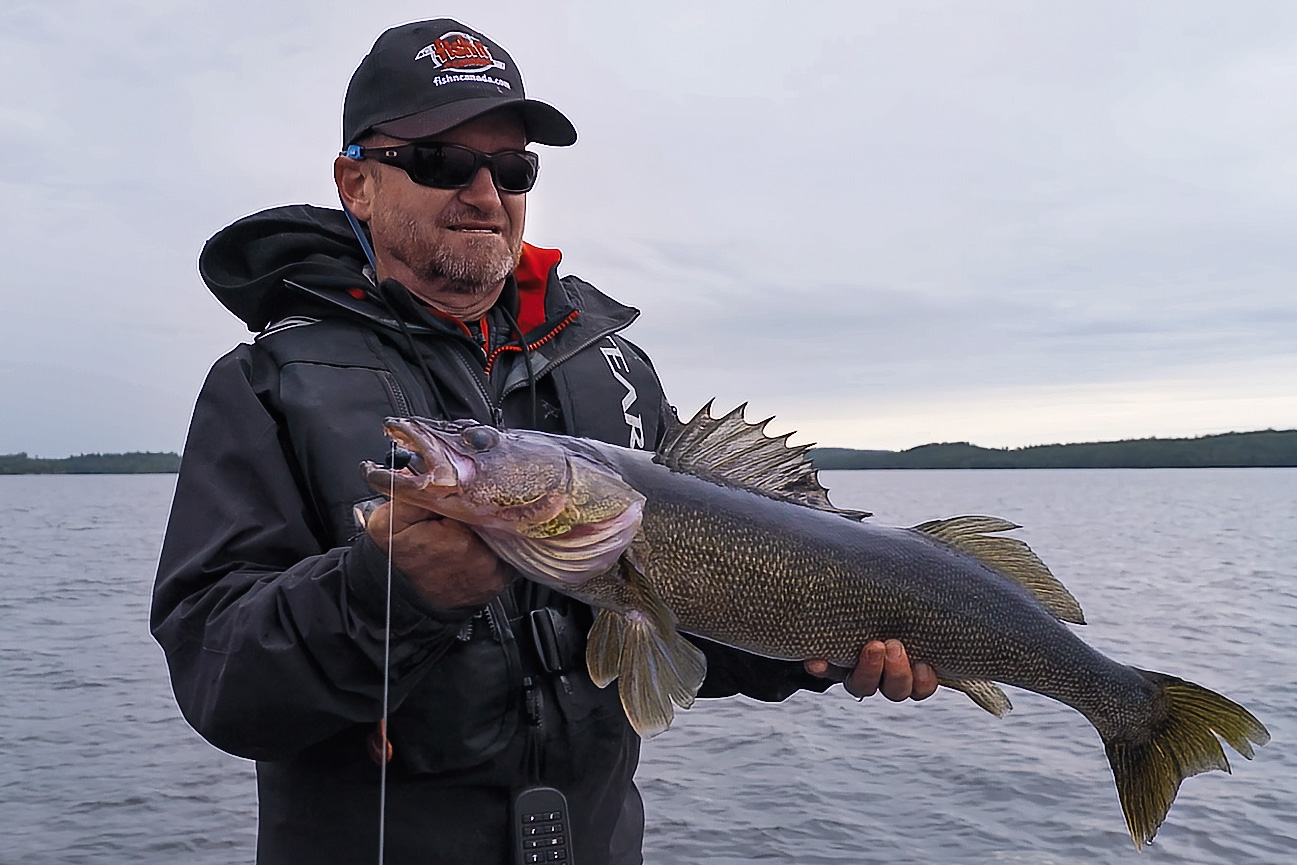
Pete with a great near-north Walleye
Lake Temagami isn’t the only body of water in the near north that will get your blood pumping. Other fantastic lakes are Temiskaming, Lady Evelyn, and Obabika to name a few of the larger water bodies.
We have actually shot Fish’n Canada shows in each of these areas.
On Temiskaming, Pete was joined by Captain John Blanchard on a great Walleye excursion in which they had a great trip with some bonus Smallmouth Bass as well.
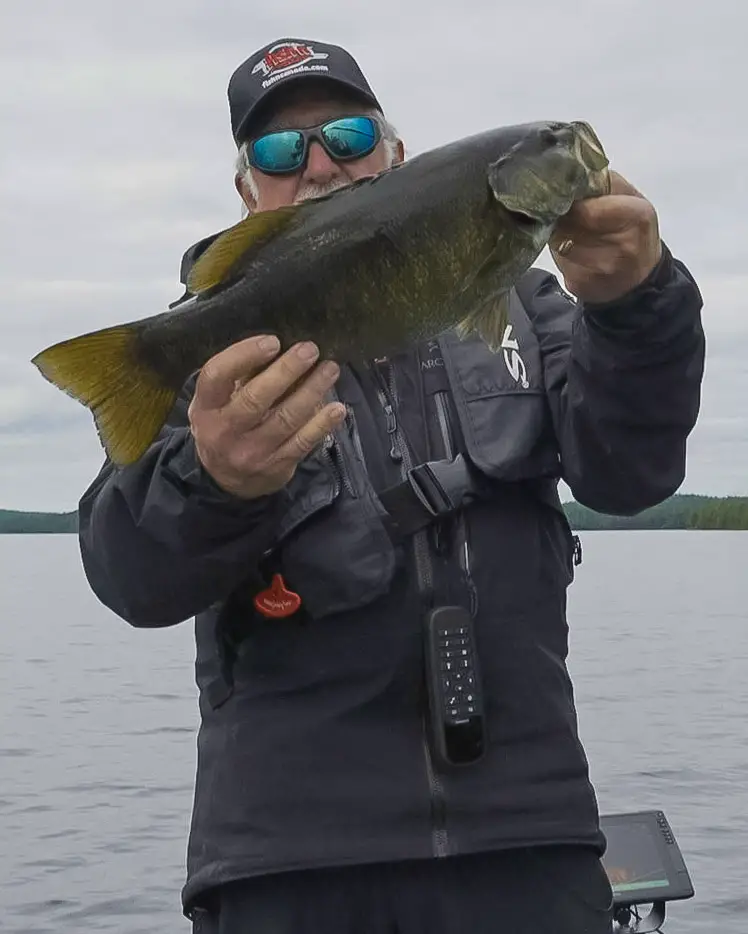
Ang holds up one of the many Smallies that he’s caught in this great fishing area
Both Ang and Pete fished Lady Evelyn for Smallmouth Bass and Walleye during a past fall and cleaned up on big fish of both species. There were some interesting events from start to finish of this shoot and all in all, a great adventure
Finally, Pete, Steve Niedzwieck, and Dean Taylor headed to Lake Obabika this season in search of Lake Trout and Smallmouth Bass. Again this area of Ontario didn’t disappoint, with success on both species. These two shows will be airing during the 2025 season.
SPECIAL THANKS
Destination Ontario https://www.destinationontario.com/en-ca
Loon Lodge https://loonlodge.com/
Adam’s Outfitting



